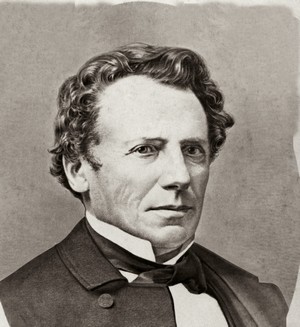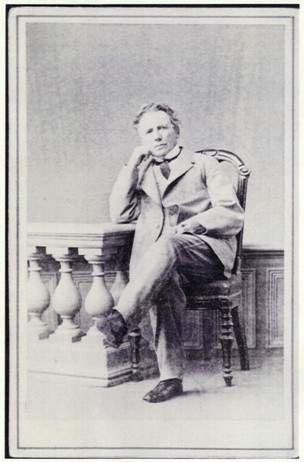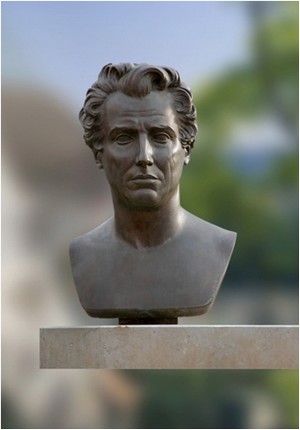A successful watchmaker and industrial pioneer from Schaffhausen.

Heinrich Moser was born on 12 December 1805 and grew up in a Schaffhausen watchmaking family. Both his grandfather, Johannes Moser (1730-1820), and his father, Erhard Moser (1760-1829), worked as town watchmakers in the town by the Rhine Falls. He learned the traditional watchmaker's craft from his father between 1820 and 1824, and went on to broaden his knowledge after 1824 in the master watchmakers' workshops in LeLocle (Switzerland). He had already come to recognize the restrictions imposed by the guild regulations, and he was a vehement opponent of these. At the same time, however, he did not ignore the quality-promoting aspects of these regulations, and he was even responsible for improving them. He rapidly gained respect as a skilled watchmaker, and he was able to start a successful small business to supply spare parts. It only took Moser about eighteen months to develop a reputation as an outstandingly talented specialist, and he received offers of work from Italy and Paris. From 1826, he was able to work for the first time on his own account for a German merchant, for whom he built clocks into cases and pieces of furniture. In November 1827, the prospect of good business drew him to St. Petersburg in Russia, where in 1828 he opened H. Moser & Co. This marked the hour of inception of what would eventually grow into such a successful brand.

Moser's business flourished, which was certainly attributable to the painstaking care that he took throughout his life to ensure that the watches sold by him were supplied to a high quality standard. Not a single watch was allowed to pass over the shop counter unless it had been inspected personally by him or one of his representatives. In order to maintain this demand on superior quality, he established a watch factory in LeLocle in 1829, which produced watches exclusively for his businesses in Europe and Russia. The building that was home to the company exists to this day.The range of Moser watches grew to include 70 different calibres. In addition to the movements supplied by his own factory, he also purchased movements from such renowned companies as Urban Jürgensen or Jaeger-LeCoultre. The latter's company archive lists him as a customer from 1860 onwards. From them he procured up to 64 different calibres, of which 24 complications. The uncompromising quality of his watches gained him access as a supplier to the Imperial Russian Court, various royal houses and the armed forces. Within just a few years, he was selling watches to Japan, China and Persia, but also in the West in Paris and New York. Business continued to thrive, even in times of crisis, and Moser, who was by now a prosperous merchant and watch manufacturer, decided to return to Schaffhausen with his family at the end of 1848.From this point on, he would see his true life's work as the transformation of Schaffhausen, a very quiet town in those days, into a lively and attractive industrial location, which also had room for a watch production facility. At the same time, he set about the construction of the magnificent Charlottenfels manor house for his family.

In 1851 he completed the construction of a canal on the Rhine, which supplied the water to drive a turbine with an output of about 80 h.p. This was followed in 1853, in a joint venture with other personalities from Schaffhausen, by the establishment of the “Schweizerische Waggonfabrik bei Schaffhausen” (Swiss Wagonworks at Schaffhausen) and, in the same year, the establishment of the “Schweizerische Industriegesellschaft (SIG) Neuhausen” (Swiss Industrial Company Neuhausen). Moser was a co-founder of the railway line Schaffhausen-Winterthur, also in 1853. Subsequent additional participations, company formations and co-financing of company formations during this period can also be attributed to his tireless involvement.In the winter of 1863/64, he embarked on the construction of the largest Swiss dam over the Rhine, with the intention of supplying neighbouring industrial companies with inexpensive energy via a power transmission system. The turbines fed their energy into huge wire cable transmission systems, which then supplied it directly to a very wide range of production halls and workshops. This hydroelectric power station marked the dawn of the industrial age in Schaffhausen.In spite of the recognition which Moser now enjoyed in Schaffhausen, he was still not untouched by disappointments. He never got over the fact that his only son, Henri Moser (1844-1923), showed no inclination to join his father's watch company, let alone to succeed him at the helm.Heinrich Moser died on 23 October 1874. His second wife, Fanny, in accordance with his last will, inherited all his business interests. This made her one of the wealthiest women in Switzerland, although she had no desire to accept responsibility for what had by now become a global watch business. She sold the entire Russian operation to the local Managing Director, Mr Winterhalter, in 1877. The watch factory in LeLocle went to Paul Girard. It was stipulated in the contracts of sale that all successor companies would continue to operate in perpetuity under the registered brand names of H. Moser & Cie. or Heinrich Moser & Co.

Heinrich Moser remains omnipresent to this day in Schaffhausen. The house in which he was born in the old town still exists, as does Charlottenfels. The modern Schaffhausen generating station today stands on the site of the historic dam on the Rhine. A large number of the businesses formed by him or with his help are still operating successfully. The residents of Schaffhausen have themselves honoured their famous fellow citizen with the eponymous Moserstrasse, with a bronze bust in the Mosergarten park that is used as a venue for events and, not least, by opening Charlottenfels to the public.
Featured brand




